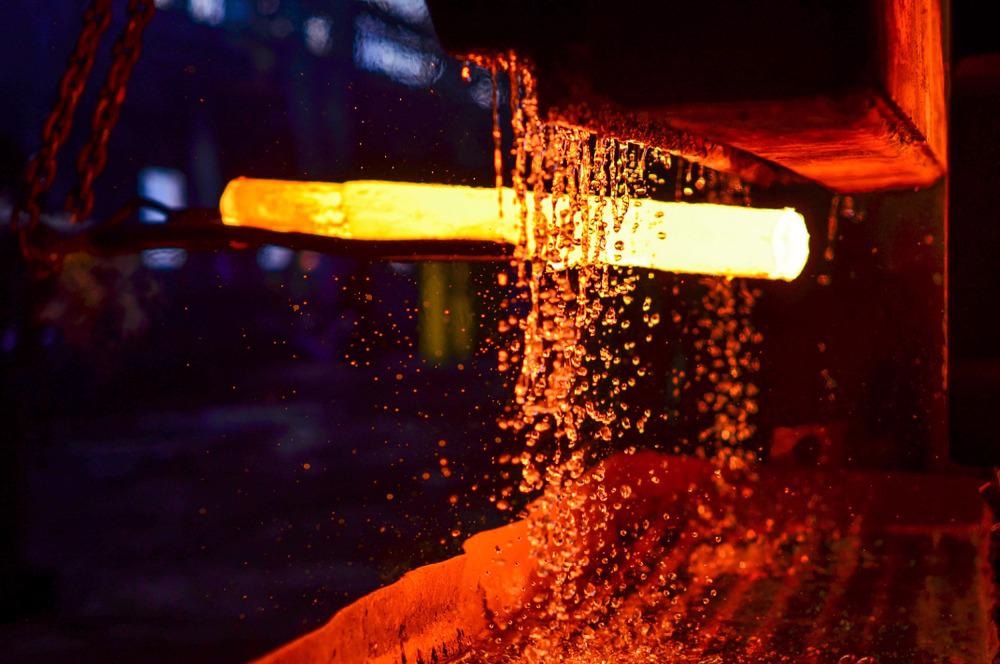
Image Credit: Maksim Safaniuk/Shutterstock.com
Steel is essential for the modern world and is used in commercial and residential buildings, automobiles, airplanes, and oil rigs and pipelines. It has unique properties such as strength, malleability, and durability, and is suited to many applications. This article will discuss how heat treatment changes steel’s properties.
Heat-Treating Steel – A History
Steel has been used by humanity for thousands of years. Iron production can be traced back to Anatolia in about 2000 BC, with the iron age well-established by 1000 BC. By 500 BC, iron technology had reached the limits of Europe, and by 400 BC, it had arrived in China. Early iron was produced in small shaft furnaces, forming as solid lumps or blooms, which were then forged into wrought iron.
When steel has a carbon content of over 0.3%, it becomes brittle. By 900 BC, Egyptians were starting to use heat to reduce this. There is evidence that they could produce heat-treated steel in China by the second and first centuries BC (the Han dynasty.) In the Western world, the Roman Empire helped spread the technology of iron and steel-making to the limits of Europe and North Africa.
A major technological breakthrough came in the 15th century with waterpower to pump air into bloomery furnaces, increasing the temperature to as much as 1200 oC, creating a liquid iron rich in carbon. Known as cast iron, this material laid the groundwork for much of the modern world. To increase the iron content again to make steel, the iron was subjected to a carburization process.
Over the next few centuries, much progress was made in the steel-making industry to refine the process and manufacture the material we are all familiar with today. Many methods have been developed, including crucibles, the Bessemer method, electric steel-making, and adding materials such as tungsten and manganese to create alloys.
Methods of Heat-Treatment
Carbon steel is an incredibly versatile material, and its properties can be altered. The material does have its limitations, including:
- Limited hardness, tensile strength, and hardness in its untreated form
- Poor oxidation resistance
- Cracking and distortion caused by drastic quenching
- Can undergo softening at high temperatures
- Large sections are difficult to harden
These limitations make steel unsuitable for specific applications in its untreated form. By adding carbon and using heat treatment, these properties can be altered within limits, creating a more robust and durable product.
Hardening
When steel with a medium to high carbon content is subjected to heat treatment, it can be hardened. Depending on steel’s carbon content, they can be heated to specific temperatures (780 oC to 850 oC) and then quenched in oil or water to cool them quickly. The higher the carbon content, the lower the temperature needed to harden the metal. This temperature is also known as the “austenitic crystal phase”.
This process alters the crystal structures within the metal, forming cementite (otherwise known as iron carbide), a hard, brittle material that is classified as ceramic in its pure form. Cementite has an orthorhombic crystal structure and is 6.67% carbon and 93.3% iron by weight.
Annealing
Annealing changes a metal's properties by altering and realigning the grain structure using heat, making the metal softer and more ductile. In this process, the steel is heated to just above its re-crystallization point, allowing it to cool slowly. A full anneal involves leaving the metal to cool in the furnace itself.
Normalizing
When heating the metal to a point higher than that of the annealing process and allowing it to air cool, the grain structure stresses can be removed. Normalizing steel gives the structure more stability and the metal can be prepared for other processes.
Tempering
Steel can be made more malleable by “tempering” it. This involves heating the metal to a predetermined temperature which depends on the level of malleability required. Tempering takes away a small amount of hardness from the steel.
Quenching
Quenching refers to the rapid cooling of hot metal using oil or water. This sets the steel, making it hard but brittle. Steel is heated and quenched several times, creating a tough product that will ensure it is strong enough to support buildings, bridges, and any other structure it may be used in.
Annealing, quenching, and tempering are generally always used in the heat treatment of steel.
Heat Treatment - Types (Including Annealing), Process and Structures (Principles of Metallurgy)
Video Credit: Metallurgy Data/YouTube.com
Conclusion
Over the last couple of millennia, steel technology has developed in leaps and bounds. Today, steel is used in nearly all facets of our built environment. However, untreated steel has the potential to fail, with potentially catastrophic results. Therefore, controlled heat treatment of steel is crucial to ensure that it has the desired properties necessary for its intended use, and heating and cooling in different ways cause different structural changes that can fine-tune the desired structure.
References and Further Reading
Britannica. Steel – History. [Online] Available at: https://www.britannica.com/technology/steel/History (Accessed 7 March 2021).
Engineerstudent. Heat Treatment - Changing properties of metal. [Online] Available at: http://www.engineerstudent.co.uk/heat_treatment.php (Accessed 7 March 2021).
Miheuprecision. How Does Heat Treatment of Steel Work? [Online] Available at: https://www.miheuprecision.com/blog/heat-treatment-of-steel (Accessed 7 March 2021).
Disclaimer: The views expressed here are those of the author expressed in their private capacity and do not necessarily represent the views of AZoM.com Limited T/A AZoNetwork the owner and operator of this website. This disclaimer forms part of the Terms and conditions of use of this website.